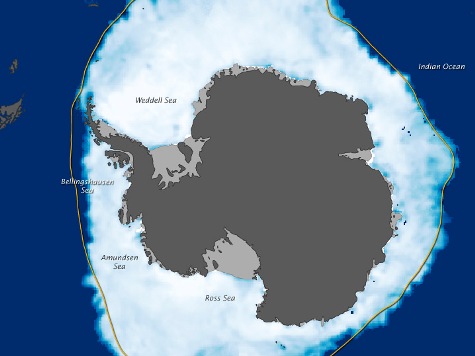
The cause of climate alarmism has suffered yet another devastating setback: new research suggests that the West Antarctic Ice Sheet is not, after all disappearing due to man-made global warming, but because it has a volcano underneath.
For years, the melting of the West Antarctic Ice Sheet (which, by the way, has been happening for around 20,000 years) has been cited by green activists as proof that man-made global warming is dangerous and real and that unless we act now to rein in carbon dioxide emissions we’ll soon resemble Waterworld.
Here, for example, is Eric Rignot – a glaciologist at NASA’s Jet Propulsion Laboratory – in the Guardian last month.
Unabated climate warming of several degrees over the next century islikely to speed up the collapse of West Antarctica, but it could alsotrigger irreversible retreat of marine-based sectors of East Antarctica.Whether we should do something about it is simply a matter of commonsense. And the time to act is now; Antarctica is not waiting for us.
And here is Mother Jones in a piece entitled “This is What a Holy Shit Moment for Global Warming Looks Like.”
That’s why scientists have long feared a day like this would come. Two new scientific papers, in the journals Science and Geophysical Research Letters, report that major glaciers that are part of the West Antarctic Ice Sheet appear to have become irrevocably destabilized. The whole process may still play out on the scale of centuries, but due to the particular dynamics of this ice sheet, the collapse of these major glaciers now “appears unstoppable,” according to NASA (whose researchers are behind one of the two studies).
But according to a new report from the Institute For Geophysics at the University of Texas at Austin, the West Antarctic Ice Sheet melt may not, after all, be the direct result of man’s selfishness, greed, and refusal to amend his carbon-guzzling lifestyle. Rather, it seems, it is the result of natural causes.
Using radar techniques to map how water flows under ice sheets, UTIG researchers were able to estimate ice melting rates and thus identify significant sources of geothermal heat under Thwaites Glacier. They found these sources are distributed over a wider area and are much hotter than previously assumed.
The geothermal heat contributed significantly to melting of the underside of the glacier, and it might be a key factor in allowing the ice sheet to slide, affecting the ice sheet’s stability and its contribution to future sea level rise.
The cause of the variable distribution of heat beneath the glacier is thought to be the movement of magma and associated volcanic activity arising from the rifting of the Earth’s crust beneath the West Antarctic Ice Sheet.

COMMENTS
Please let us know if you're having issues with commenting.